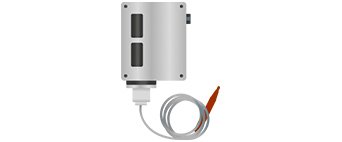Wide range of thermostats and humidistats for the control of any civil or industrial process
Temperature is the property that characterizes the thermal state of two systems in relation to the direction of the heat flow that would arise between them.
Regulates the transfer of thermal energy or heat from one system to another. When two systems are in thermal equilibrium, no heat exchange occurs, when there is a temperature difference, the heat will tend to move from the system at higher temperatures to that at a lower temperature, until the thermal equilibrium is reached.
Temperature does not measure the amount of thermal energy of a system, but is connected to it.
The temperature sensors that Riels® Instruments offers are the following:
- Resistance thermometers
- Thermocouples
- Temperature transmitters
- Analog thermostats and digital thermostats
- ATEX thermostats
- Thermometers
- Heating cable
- Data loggers
- Digital thermoregulators
The unit of measurement used by the International System is the Kelvin (K), which is the fraction 1/273.16 of the temperature interval between the triple point of water and absolute zero.
Other known scales are the Celsius scale (°C) which assigns the melting point of ice to 0°C and the boiling point of water to 100°C, the Fahrenheit scale (°F) which assigns the boiling point to 32°F melting point of ice and 212°F the boiling point of water.
Thermoresistances, also called resistance thermometers are temperature sensors that exploit the variation in the resistivity of some materials as the temperature varies. The resistance thermometers are built with materials that satisfy the following characteristics: high temperature range, high electrical resistivity and high temperature coefficient.
The metallic materials most used for the construction of resistance thermometers are Platinum (Pt), used in almost all applications, Nickel (Ni) is also occasionally used, in applications with modest temperature variations, and Copper is more rarely used ( Cu). Resistance thermometers are built in two different ways: wound wire, suitable for temperatures up to 300°, embedded wire, for temperatures even over 500°. Thermoresistance has excellent measurement precision and a high temperature range (in the case of those in Platinum) but their constitution makes them very sensitive to shocks and vibrations.
Thermocouples are formed by two metal conductors of different materials which, under the effect of temperature, generate an electromotive force. Thermocouples exploit the principle of thermoelectric effects: in a circuit formed by two different metallic conductors, when the junctions are at different temperatures, a current will circulate produced by the electromotive force whose intensity is directly proportional to the temperature difference between the two junctions.
The materials constituting the thermocouples have been standardized over time and chosen according to the performance and industrial fields of use on the basis of the following characteristics: electromotive force generated, stability and reproducibility, working field, atmosphere, cost. The thermocouple has good measurement accuracy and a good response time at the expense of less repeatability of the measurement.
The temperature transmitters convert the signal coming from electrical thermoelements, such as resistance thermometers and thermocouples, into a standardized 4÷20mA direct current signal or a 0-10V voltage signal.
Temperature transmitters can be mounted on a switch cabinet, connected to the thermocouple via cable, or directly on the instrument head. Mounting the thermoresistance or thermocouple on the head has significant advantages over panel mounting. This type of assembly reduces the sensitivity to disturbances induced in the presence of connection cables, thus reducing the electromagnetic and/or radiomagnetic interference present in the system.
Temperature transmitters can be supplied ATEX intrinsically safe certified.
Thermostats consist of a switch whose on-off action is controlled by a temperature variation of a sensitive element which is part of the instrument itself. The function of the thermostat can be that of regulating a flow, i.e. acting on a physical component to modify its management, or of an electrical switch, to control an electrical device which will control, in a more or less various way, the organs which influence the scanned temperature.
The thermostats can work in two different ways: with automatic reset, where an electric contact is switched when the temperature drops below the set value, with max. reset, where an electric contact switches when the temperature exceeds the set one.
The thermostat is used in process, ventilation, refrigeration and heating systems.
ATEX thermostats differ from ordinary thermostats in that they have the ATEX approval with the highest classification.
ATEX thermostats have very high protection against overpressure, are also suitable for offshore applications, are resistant to shocks and vibrations and maintain perfect setpoint stability over time.
The datalogger is a battery powered instrument, ideal for recording temperature over long periods of time.
The datalogger consists of a sealed stainless steel tube, where the sensor electronics and the battery are housed, to read the data this type of data logger must be recovered from the measurement point. There is also another version of data logger which is connected to a receiver via a cable, and therefore it is not necessary to recover the instrument.
The datalogger accepts as input analog signals coming from thermoresistances and/or thermocouples probes.
Digital temperature controllers can be connected to any type of sensor, any linear signal and even non-linear signals.
Digital thermoregulators can carry out discontinuous regulation with single and double action, continuous and servo motor. They include two initial "one shot" tuning methods and an automatic system which, based on the process conditions, selects the optimal one. The digital thermoregulators are also equipped with a password-protected customizable display that allows the operator to quickly reach the information he is looking for and to hide it or prevent it from being modified.
Digital thermoregulators can carry out discontinuous regulation with single and double action, continuous and servo motor. They include two initial "one shot" tuning methods and an automatic system which, based on the process conditions, selects the optimal one. The digital thermoregulators are also equipped with a password-protected customizable display that allows the operator to quickly reach the information he is looking for and to hide it or prevent it from being modified.
The digital thermoregulators are also equipped with the modbus protocol, to be easily connected to other peripherals.
Mechanical expansion thermometers exploit the variations caused by the temperature on the volume of solid materials, liquids, gases and vapours. In the different materials, different functional relationships are used: in solids there is the elongation of different metallic materials with different coefficient of thermal expansion, in liquids there is the raising of a column of liquid or the pressure caused by the thermal expansion of the liquid at constant volume, while in gases and vapors there is the pressure caused by the thermal expansion of the gas at constant volume. Based on these functional relationships, thermometers are divided into two categories: column thermometers, which exploit the rise of a column of liquid as the temperature varies, and dial thermometers, which are based on the expansion of solids or gases and vapors .
The construction of the latter type of thermometers can be of two types: with a bimetallic foil, in expansion thermometers, or with a bulb-capillary, in gas expansion thermometers.
These thermometers are suitable for hostile environments and also boast good accuracy, but do not allow remote data transmission.
The heating cable or self-regulating cable increases or decreases the dissipated power as the temperature decreases or increases, regardless of the length of the circuit. This leads to the main qualities of the heating cable: energy consumption in relation to real thermal conditions, reduced design activities, possibility of cutting or splicing directly on site to the desired length without the power per meter varying. The heating cable is mainly applied in antifreeze systems, heating and temperature maintenance of tanks and pipes and prevention of accumulation of ice and snow on ramps. The heating cable can also be supplied in an ATEX explosion-proof version.







